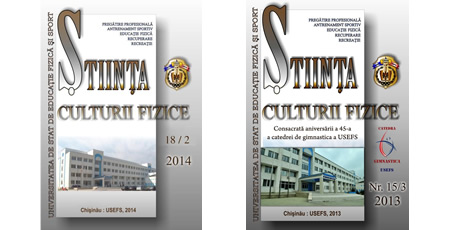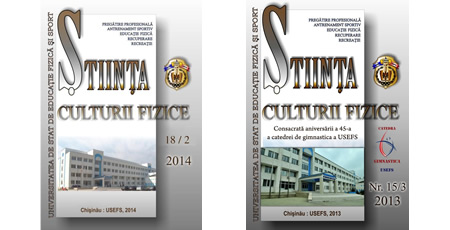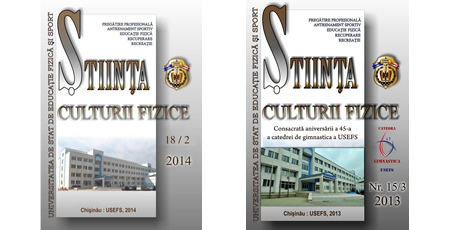RULES FOR IMPROVING ARTICLES FOR PUBLISHING IN THE SCIENTIFIC-THEORETICAL JOURNAL "SCIENCE OF PHYSICAL CULTURE"
The journal "Science of Physical Culture" publishes in its pages scientific articles that reflect the results of both experimental and scientific-theoretical research. The editorial office accepts for analysis works elaborated according to the following thematic directions:- current issues of physical education and sports;
- physical education for various categories of population;
- professional-applied physical training;
- professional training and improving staff for the activity in the field of physical culture and sports;
- recreational and adaptive physical culture;
- physical and medical rehabilitation;
- Olympism and sports history;
- current problems of the theory and methodology of training athletes at various stages of multiannual training;
- sociology, psychology, pedagogy, management, economics and law in the field of physical education and sports;
- tourism;
- biomechanical and information technologies in physical culture and sports;
- technologies for maintaining health;
- sports medicine;
- physiology, morphology, pharmacology, biochemistry and sports genetics;
- kinesiology;
- philosophical aspects of physical culture and sports, etc.
The journal "Science of Physical Culture" publishes articles in Romanian, Russian and English. The content of the article must correspond to the following criteria: actuality, scientific novelty, profile, theoretical or practical value.
Guide for authors
The volume of theoretical-scientific articles should not exceed 20 pages of author's text, but of the experimental nature - 15 pages, including figures, tables, keywords, annotation and bibliography. Minimum volume of the publication - 7 pages. Text editor - Microsoft Word, A4 format. Edges: top, bottom, left, right - 2,5 cm. Character type - Times New Roman, dimensions 12 pt, space between rows - 1,5, paragraph - 1,00. Table text - Times New Roman, dimensions 10 pt, space between rows - 1,0.The titles of the tables must be placed above them and not contain abbreviations. The notes to the tables are placed below them, they are executed with characters of the type used in the basic text (dimensions 10 pt).
In the text of the article, references to bibliographic sources are numbered in square brackets. In case the reference is made to a single author, it is necessary to indicate the pages, for example: [15, p. 14-15].
All illustrations must be executed taking into account the possibility of editing them. Figures, diagrams, graphs, etc. is numbered. The title of the figure, diagram, graph must be collected with the same characters as the basic text (12 pt), placed under them, without abbreviations.
Article structure
The article must contain:1. Article title (in capital letters)
The title should be informative, include keywords and not contain abbreviations. The number of words in the title of the paper - maximum twelve.
2. Name and surname of the author
It is recommended to limit the number of article authors to three.
3. The name of the institution where the author works, city, country
If there are several authors, a numerical index is placed next to each name and the respective organization. However, if the authors work within the same institution, the place of work of each one will not be indicated.
Example of presenting the information according to division no. 1-3
MULTI-PARAMETRIC ANALYSIS OF THE COMPETITIVE EXERCISE KINEMATICS AND MODELING THE OPTIMAL MOTOR REGIME OF IT
Axxxx Axxxxx1, Bxxxxx Bxxxxx2, Cxxxxxx Cxxxxxx3
2Ecological University of Bucharest, Romania
4. The annotation / Abstract (abstract) will contain the object, purpose, hypotheses of the research, methods, results and conclusions and must not exceed 300 words.
5. Keywords, maximum 6 words.
6. The text of the article
The basic text must be structured in the following order: Introduction; Methodology and research organization; Research results and their analysis; Conclusions; Bibliography. If it is a synthesis article, its structuring is not mandatory.
Introduction
Introduction volume - 1-2 pages. In the introduction, the research problem will be formulated, the analysis of its results will be presented, which have been reflected in the publications where variants of solving the given problem have been formulated, upon which the author of the respective work is based. The aspects of the problem that have not been analyzed before to which the article is dedicated are highlighted. In the same section it is necessary to argue the actuality of the problem, the scientific novelty, its theoretical or practical value.
Methodology and research organization
In this section of the article, the purpose and objectives of the research must be clearly formulated and its methods and organization described in detail. The purpose of the research must be to solve the problem reflected in the title of the paper. It determines the options for achieving it, allows the most accurate realization of the objectives. It is recommended that the formulation of the objectives to be achieved in the research start with the words: to elaborate, to establish, to determine, to highlight, to argue, etc. The detailed description of the methods applied in the research is welcome only if they are insufficiently known. The author should not limit himself to the nomination of methods, it is necessary to argue the use of their selection. When describing the organization of the research, it is necessary to present the following data: place, conditions, time and duration of the experiment; gender, age, sports qualification and specialization, as well as other information about the contingent of subjects included in the experiment; applied tool methodologies; the equipment used in the experiment, the experiment program and the implemented innovations.
Research results and discussions on them
In this section, the author must present the results of the research, with a broad scientific argument. The data obtained during the research, processed with the help of statistical analysis methods, must be presented in the form of tables, diagrams, graphs. The titles of tables, graphs or diagrams must correspond to their content. The results obtained in the research must be subject to analysis, confronted with data already known and analyzed from the point of innovation view.
Conclusions
The conclusions must contain a brief formulation of the research results. They must correspond to the purpose and objectives, to result from the basic content of the paper, to be formulated clearly, laconic, with accuracy. In the conclusions it is necessary to indicate also the practical importance of the research results.
7. Bibliography
The bibliographic list must be placed at the end of the text. In the original articles, we recommend to indicate no more than 10 sources, but in the synthesis ones - maximum 20, of which not less than 30% published during the last 5 years. It is forbidden to include any publications without ISSN and ISBN.
The sources are numbered in alphabetical and chronological order. It is indicated first the works published in the language in which the article was written, then - those in other languages. The works of the same author must be presented in the bibliography in chronological order.
All references to bibliographic sources must be made in accordance with the APA style http://www.apastyle.org
8. E-mail: for each author.
AUTHORS 'INFORMATION AND CONTACT DETAILS
- Name, surname;- The name of the organization where the author works, city, country;
- scientific degree and position held;
- post code, address;
- telephone numbers: work, home and mobile;
- e-mail.









